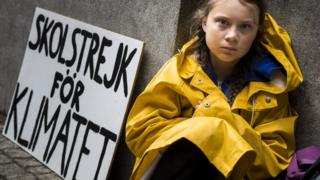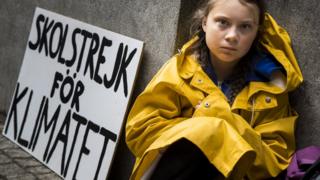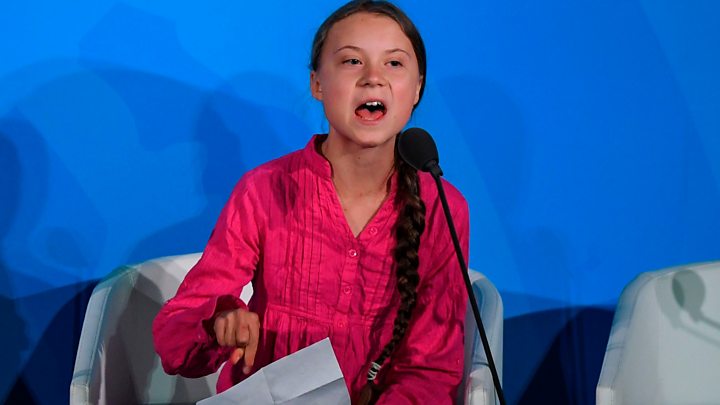Who is Greta Thunberg, the teenage climate change activist?
The Swedish teenager started a climate change protest that grew into a global movement of millions. …

 Image copyright Getty Images
Image copyright Getty Images One day in late August 2018, Greta Thunberg took up position outside Sweden’s Parliament for the first time. She held a simple sign, black letters on a white board, that said “School Strike for Climate.”
“It felt like I was the only one who cared about the climate and the ecological crisis,” she told the BBC. The 15-year-old was by herself, but not for long.
Within a year, her school strike, carried on through all weather, had inspired millions of young people around the world to take to the streets and demand action on climate change.
As thousands of students again protest in major global cities, here’s a look at what we know about the teenager who started it all.
Where did she grow up?
Ms Thunberg, the elder of two girls, was born on 3 January, 2003. She grew up in Stockholm with her mother Malena Ernman, an opera singer and former Eurovision Song Contest participant, and her actor father Svante Thunberg. Her father is a descendant of Svante Arrhenius, a scientist who came up with a model of the greenhouse effect. He was awarded the Nobel Prize for Chemistry in 1903.
Ms Thunberg said her parents were “as far from climate activists as possible” before she made them aware of the issue. She persuaded her parents to become vegan, and in 2016 convinced her mother to stop flying, despite her mother frequently travelling overseas for work.
They have co-written a book with their daughter called Our House is on Fire: Scenes of a Family and a Planet in Crisis. It is set to be released in March.
Ms Thunberg has Asperger’s Syndrome, a developmental disorder, and has described it as a gift and a superpower.

Media playback is unsupported on your device
How did she get involved in protesting?
She says she first learned about climate change when she was eight and couldn’t understand why people weren’t taking action.
“I remember thinking it was very strange that we were capable of changing the entire face of the Earth and the precious thin layer of atmosphere that makes it our home. Because if we were capable of doing this, then why weren’t we hearing about it everywhere?” she wrote in the Guardian.
In May 2018, Ms Thunberg won a climate change essay competition in a local newspaper. Three months later, she decided to start protesting in front of the Swedish parliament building, vowing to continue until the government met the carbon emissions target set out by world leaders in Paris in 2015.
Ms Thunberg said her parents weren’t enthusiastic about her protest at the start, and told her that she would have to do it without their help.
How did her protests grow into a global movement?
After she was pictured outside the Swedish parliament building with her sign, the teenager’s protests went viral on social media.
As support for her cause grew, other strikes started around the world, and the message spread with the hashtag #FridaysForFuture. By December 2018, more than 20,000 students around the world had joined her in countries including Australia, the UK, Belgium, the US and Japan.
Ms Thunberg travelled to some of the strikes in Europe, choosing to travel by train to limit her impact on the environment.
In April, she made an appearance at the Extinction Rebellion protests in London, telling the crowd: “For way too long, the politicians and the people in power have gotten away with not doing anything. We will make sure that politicians will not get away with it for any longer.”
In September, Ms Thunberg travelled to New York address the UN Climate Conference. She made her way there on a zero-emissions boat in a journey that lasted two weeks.
The week of her arrival, millions of people around the world took part in a climate strike, underlining the scale of her influence.
During her address at the UN, she blasted politicians for relying on young people for answers to climate change.
“How dare you,” she said. “I shouldn’t be up here. I should be back in school on the other side of the ocean, yet you all come to us young people for hope. How dare you?
“You have stolen my dreams and my childhood with your empty words. We will be watching you.”
At the end of 2019, she was named Time Magazine’s Person of the Year.
What do her critics say?
Her message has not been well received by everyone, most notably prominent conservative voices. But she has responded defiantly and often with humour.
After her UN appearance, US President Donald Trump appeared to mock her by saying she “seems like a very happy young girl looking forward to a bright and wonderful future”.
Ms Thunberg then changed her Twitter biography to include Mr Trump’s words. She did the same weeks later when Russian President Vladimir Putin called her a “kind but poorly informed teenager”.
In January, US Treasury Secretary Steven Mnuchin told the teenager to go away and study economics before lecturing investors. His comments came after she called on world leaders to abandon fossil fuels at the World Economic Forum in Davos.
As for the teenager’s schooling, she took the whole of 2019 off school to be able to attend the climate conference in New York and the world’s major annual climate summit in Madrid in December.


